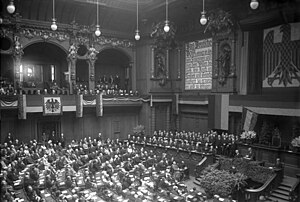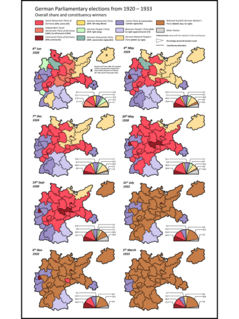Reichstag (Weimar Republic)
The Reichstag convened for the first time on 24 June 1920, taking over from the Weimar National Assembly, which had served as an interim parliament following the collapse of the German Empire in November 1918.Under the Weimar Constitution of 1919, the Reichstag was elected every four years by universal, equal, secret and direct suffrage, using a system of party-list proportional representation.[1] The Reichstag voted on the laws of the Reich and was responsible for the budget, questions of war and peace, and confirmation of state treaties.It could force individual ministers or the entire government to resign by means of a vote of no confidence, and under Article 48 of the constitution[2] it could rescind emergency decrees issued by the Reich president.[2] The Reichstag as a free and democratic institution ceased to exist following the passage of the Enabling Act of 1933 which granted Chancellor Adolf Hitler the power to draft and enforce laws as he pleased.Those who could not exercise the right to vote were active duty soldiers, people living in a sanatorium or nursing home and those in criminal or pre-trial detention.In 1933 the National Socialists used the two constitutional articles, along with the ability to transfer the legislative function from the Reichstag to the government through an Enabling Act, to establish a dictatorship.



Reichstag buildingReichstag (disambiguation)GermanyLower house23 March 1933Weimar National AssemblyGroßdeutscher ReichstagVoting systemParty-list proportionalrepresentation6 June 19205 March 1933Constitution of the German ReichWeimar RepublicReichsratGerman EmpireWeimar Constitutionproportional representationArticle 48Reich presidentEnabling Act of 1933Adolf Hitlervote of no confidenceReich lawlast Reichstag election under the Empiresecond votesEast PrussiaProvince of East PrussiaBerlinKreuzbergWeddingFriedrichshainPrenzlauer BergTiergartenPotsdam IITeltowBeeskowStorkowZehlendorfCharlottenburgWilmersdorfSchönebergSteglitzTempelhofNeuköllnTreptowKöpenickPotsdam ISpandauReinickendorfPankowWeißenseeLichtenbergFrankfurt an der OderFrankfurtProvince of Posen–West PrussiaPomeraniaProvince of PomeraniaBreslauLiegnitzOppelnProvince of Upper SilesiaMagdeburgFree State of AnhaltMerseburgThuringiaState of ThuringiaSchmalkaldenSchleswig-HolsteinProvince of Schleswig-HolsteinWeser-EmsFree State of OldenburgBirkenfeldFree Hanseatic City of BremenEast HanoverLüneburgSouth Hanover–BraunschweigHanoverFree State of BrunswickWestphalia NorthMünsterMindenFree State of LippeFree State of Schaumburg-LippeSchaumburgWestphalia SouthArnsbergHesse-NassauProvince of Hesse-NassauWetzlarFree State of WaldeckCologne–AachenCologneKoblenz–TrierLandesteile of BirkenfeldDüsseldorf EastDüsseldorfElberfeldBarmenDistrict of MettmannRemscheidSolingenDüsseldorf WestDistrict of CleveCrefeldDuisburgOberhausenMülheimHambornMönchen-GladbachRheydtUpper Bavaria–SwabiaUpper BavariaSwabiaLower Bavaria–Upper PalatinateLower BavariaUpper PalatinateFranconiaMiddle FranconiaUpper FranconiaLower FranconiaPalatinateDresden–BautzenDresdenBautzenLeipzigChemnitz–Zwickau